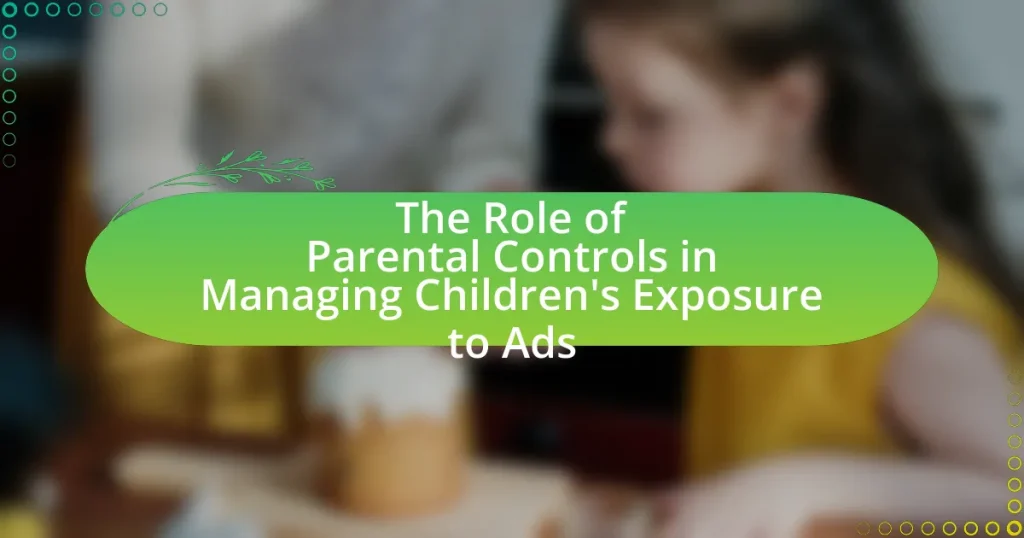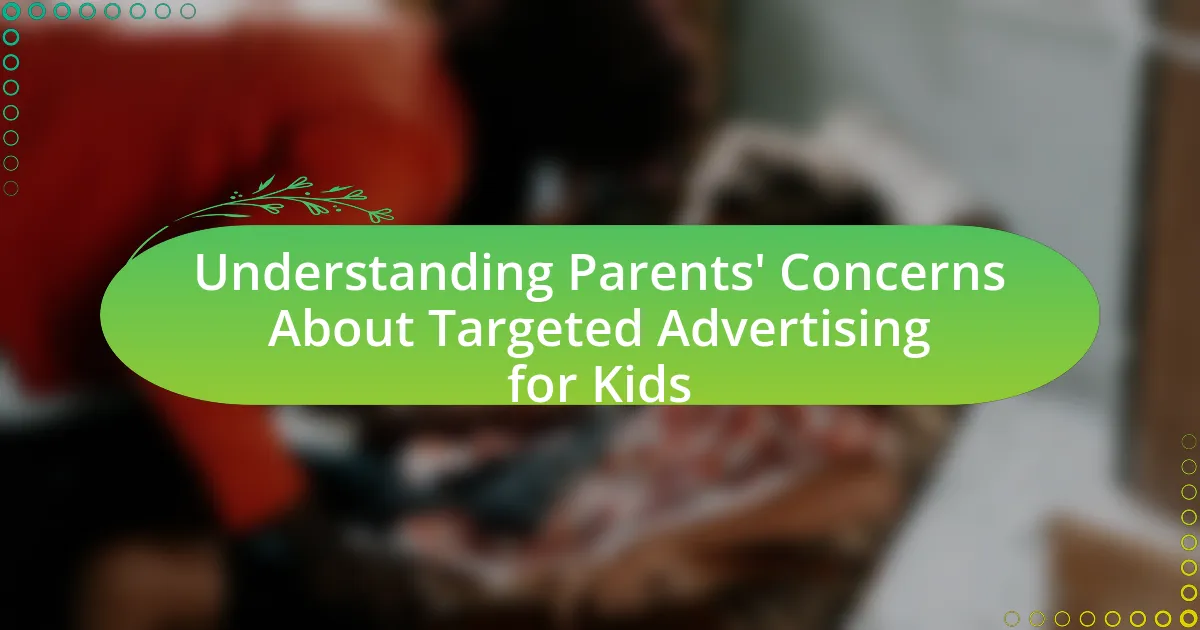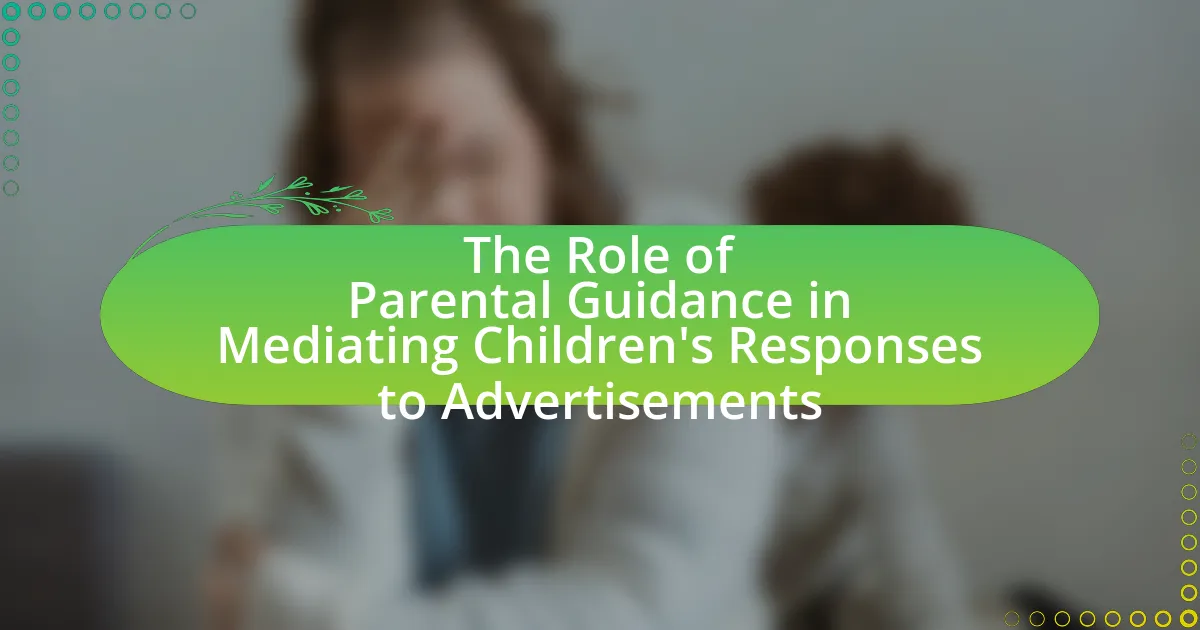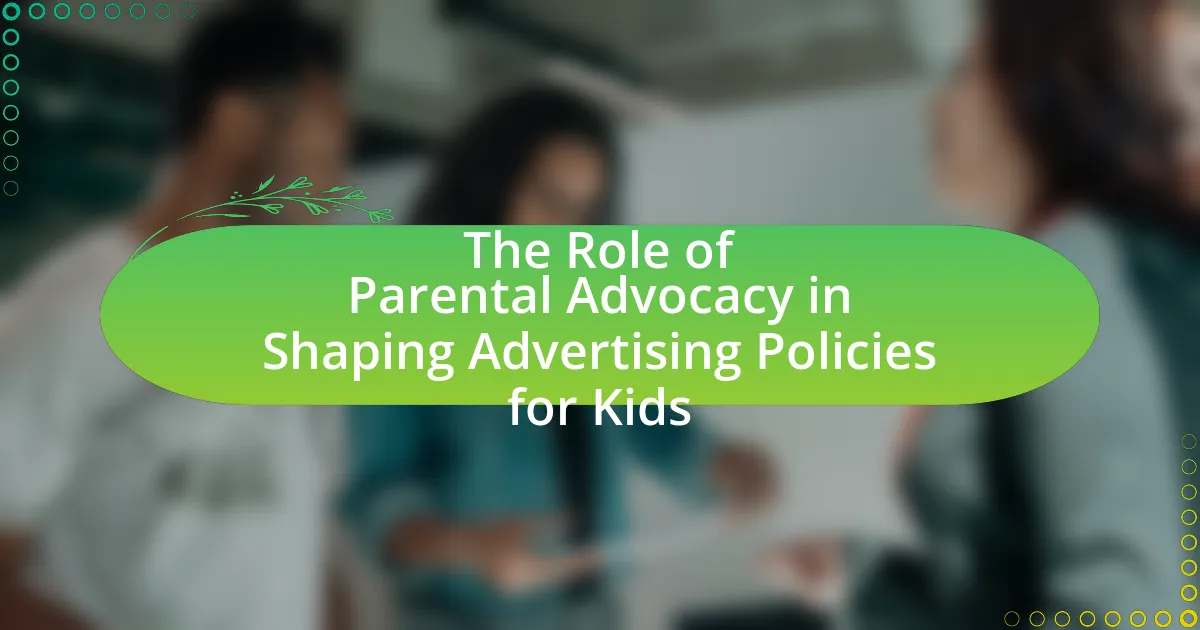Parental controls are essential tools that enable parents to monitor and restrict their children’s access to digital content, particularly advertisements. These controls play a critical role in managing children’s exposure to potentially harmful advertising, which can influence their preferences and behaviors. The article explores how parental controls function across various platforms, the types available for managing ad exposure, and the psychological effects of advertising on children. It also discusses the importance of age-appropriate settings, effective monitoring strategies, and best practices for parents to enhance the effectiveness of these controls, ultimately aiming to create a safer online environment for children.
What are Parental Controls and Their Importance in Managing Children’s Exposure to Ads?
Parental controls are tools and features that allow parents to monitor and restrict their children’s access to content, including advertisements, on digital platforms. These controls are crucial in managing children’s exposure to ads, as they help limit the influence of potentially inappropriate or misleading advertising targeted at young audiences. Research indicates that children are particularly susceptible to advertising messages, which can shape their preferences and behaviors. By utilizing parental controls, parents can create a safer online environment, ensuring that children are not exposed to ads that promote unhealthy products or unrealistic standards. This proactive approach is supported by studies showing that children who are shielded from excessive advertising are less likely to develop negative body image issues and unhealthy eating habits.
How do parental controls function in digital environments?
Parental controls function in digital environments by allowing parents to set restrictions on their children’s access to content and features across various platforms. These controls enable parents to filter inappropriate content, limit screen time, and monitor online activities, ensuring a safer digital experience for children. For instance, many devices and applications offer built-in parental control settings that can block specific websites, restrict app downloads, and provide usage reports. Research indicates that 70% of parents use some form of parental control to manage their children’s online exposure, highlighting the effectiveness of these tools in promoting responsible digital behavior.
What types of parental controls are available for managing ad exposure?
Parental controls for managing ad exposure include content filtering, ad-blocking software, and platform-specific settings. Content filtering allows parents to restrict access to certain websites or apps that display unwanted advertisements. Ad-blocking software can be installed on devices to prevent ads from appearing across various platforms. Additionally, many social media and streaming services offer built-in parental controls that enable parents to limit ad exposure based on age-appropriate content guidelines. These tools collectively help parents safeguard their children from inappropriate or excessive advertising.
How do these controls differ across various platforms and devices?
Parental controls differ significantly across various platforms and devices in terms of functionality and user interface. For instance, mobile devices like smartphones and tablets often provide built-in parental control features that allow parents to restrict app usage and screen time, while smart TVs may offer content filtering options based on age ratings. Additionally, gaming consoles typically include settings to limit online interactions and control in-game purchases. Research indicates that 70% of parents utilize these controls to manage their children’s exposure to inappropriate content, highlighting the importance of tailored features across different platforms. Each platform’s unique approach to parental controls reflects its specific user demographics and usage contexts, ensuring that parents can effectively monitor and manage their children’s media consumption.
Why is it essential to manage children’s exposure to ads?
It is essential to manage children’s exposure to ads to protect their cognitive development and promote healthier consumption habits. Children are particularly vulnerable to advertising messages, which can influence their preferences, behaviors, and understanding of needs versus wants. Research indicates that children under the age of eight often cannot distinguish between advertising and programming, leading to increased susceptibility to persuasive techniques used in ads. For instance, a study published in the journal “Pediatrics” found that children exposed to food advertisements are more likely to choose unhealthy food options, contributing to rising obesity rates among youth. Therefore, managing exposure through parental controls can help mitigate these risks and foster critical thinking about media consumption.
What psychological effects can advertising have on children?
Advertising can significantly influence children’s psychological development, leading to effects such as increased materialism, altered self-esteem, and unhealthy eating habits. Research indicates that children exposed to advertising are more likely to develop a preference for branded products, which can foster materialistic values and diminish intrinsic motivation. A study published in the Journal of Consumer Research found that children who frequently view advertisements tend to equate happiness with the acquisition of products, impacting their overall well-being. Additionally, advertisements often promote unhealthy food choices, contributing to issues like obesity and poor body image among children, as highlighted by the American Psychological Association. These psychological effects underscore the importance of parental controls in managing children’s exposure to advertisements.
How does excessive ad exposure impact children’s behavior and choices?
Excessive ad exposure negatively impacts children’s behavior and choices by increasing materialism and influencing unhealthy eating habits. Research indicates that children exposed to high levels of advertising are more likely to develop a preference for unhealthy foods, as demonstrated in a study published in the journal “Pediatrics,” which found that children who viewed more food advertisements consumed more calories and preferred sugary snacks. Additionally, excessive advertising fosters a sense of entitlement and unrealistic expectations, leading to dissatisfaction with their own possessions and increased pressure to conform to marketed ideals. This correlation between ad exposure and behavioral changes highlights the importance of parental controls in managing children’s media consumption to mitigate these adverse effects.

What are the Key Features of Effective Parental Controls?
Effective parental controls feature content filtering, time management, activity monitoring, and customizable settings. Content filtering allows parents to block inappropriate websites and apps, ensuring children access only age-appropriate material. Time management features enable parents to set limits on screen time, promoting a healthy balance between online and offline activities. Activity monitoring provides insights into children’s online behavior, helping parents identify potential risks. Customizable settings allow parents to tailor controls to their child’s specific needs and maturity level, enhancing the effectiveness of the parental control system. These features collectively empower parents to manage their children’s exposure to ads and online content effectively.
How can parents customize settings to suit their child’s needs?
Parents can customize settings to suit their child’s needs by utilizing parental control features available on devices and applications. These features allow parents to set restrictions on content, limit screen time, and manage access to specific apps or websites, ensuring that the child’s exposure to advertisements is appropriate for their age and maturity level. For instance, many platforms provide options to filter out ads based on content ratings, enabling parents to block inappropriate advertisements effectively. Additionally, studies indicate that children are more susceptible to advertising influences, making it crucial for parents to actively engage in customizing these settings to create a safer digital environment.
What specific features should parents look for in parental control software?
Parents should look for features such as content filtering, screen time management, activity monitoring, and location tracking in parental control software. Content filtering allows parents to block inappropriate websites and apps, ensuring children are not exposed to harmful content. Screen time management enables parents to set limits on device usage, promoting healthier habits. Activity monitoring provides insights into children’s online behavior, helping parents understand their digital interactions. Location tracking ensures parents can keep tabs on their children’s whereabouts for safety. These features collectively empower parents to effectively manage their children’s exposure to ads and online content.
How do content filters enhance the effectiveness of parental controls?
Content filters enhance the effectiveness of parental controls by allowing parents to block inappropriate content based on specific criteria, such as keywords, categories, or ratings. This targeted filtering ensures that children are less likely to encounter harmful or unsuitable material while browsing online. For instance, a study by the American Academy of Pediatrics indicates that children exposed to inappropriate content are more likely to develop negative behaviors, highlighting the importance of effective filtering mechanisms. By implementing content filters, parents can create a safer online environment, thereby reinforcing the overall efficacy of parental controls in managing children’s exposure to ads and other online content.
What role do age-appropriate settings play in managing ad exposure?
Age-appropriate settings are crucial in managing ad exposure by ensuring that children are only exposed to content suitable for their developmental stage. These settings help filter out inappropriate advertisements that may not align with a child’s understanding or maturity, thereby reducing the risk of negative influences. Research indicates that children are more susceptible to advertising messages, and age-appropriate settings can mitigate this vulnerability by restricting access to ads that promote unhealthy behaviors or unrealistic ideals. For instance, studies show that children aged 8-12 are particularly influenced by ads, making it essential for parents to utilize these settings to protect their children from exposure to harmful content.
How can parents determine the appropriate age settings for their children?
Parents can determine the appropriate age settings for their children by evaluating the content and features of the media or platform in question against their child’s developmental stage and maturity level. Research indicates that children aged 2-5 benefit from content that promotes basic skills and social interaction, while those aged 6-12 require age-appropriate educational and entertainment content that fosters critical thinking. Additionally, parents can refer to guidelines provided by organizations such as the American Academy of Pediatrics, which recommends limiting screen time and ensuring that content is suitable for the child’s age group. By aligning these factors, parents can effectively set age restrictions that protect their children from inappropriate content while promoting healthy media consumption.
What are the consequences of not using age-appropriate settings?
Not using age-appropriate settings can lead to increased exposure of children to inappropriate content, which may result in negative psychological effects such as anxiety, confusion, and desensitization to violence. Research indicates that children exposed to violent media are more likely to exhibit aggressive behavior and fearfulness (Anderson et al., 2003, “Violent Video Game Effects on Aggression, Empathy, and Prosocial Behavior in Children: A Meta-Analytic Review”). Additionally, inappropriate content can distort children’s understanding of social norms and relationships, leading to unhealthy attitudes and behaviors. Therefore, the absence of age-appropriate settings significantly compromises the safety and well-being of children in digital environments.
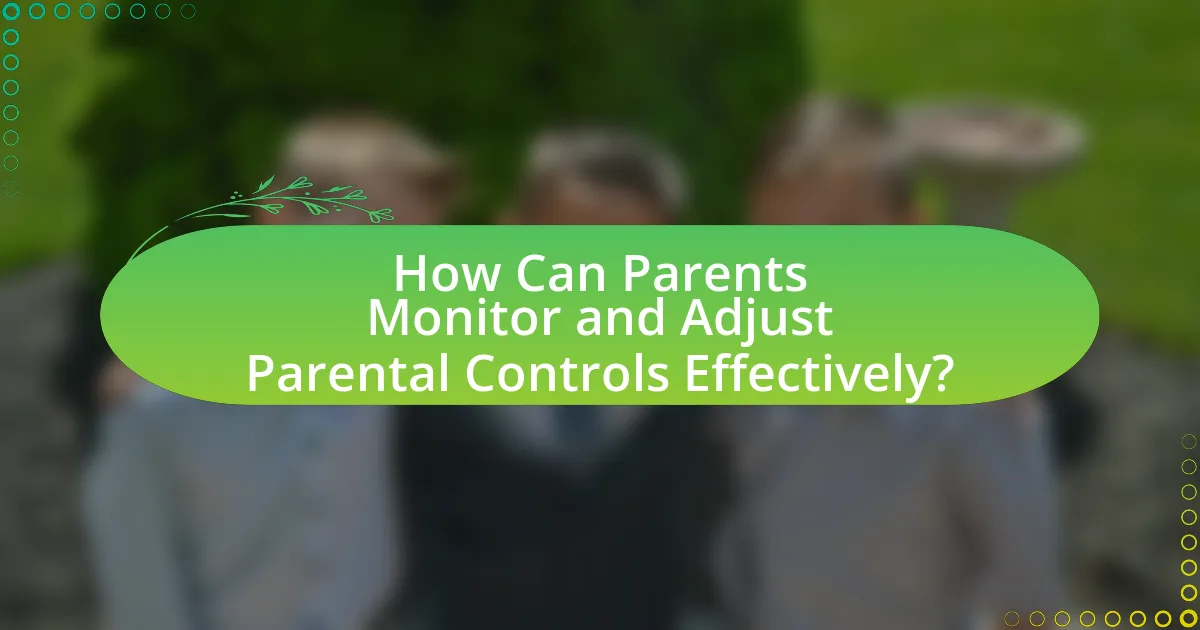
How Can Parents Monitor and Adjust Parental Controls Effectively?
Parents can monitor and adjust parental controls effectively by utilizing built-in features on devices and applications that allow for real-time tracking and customization of content access. Many platforms, such as streaming services and social media, provide specific parental control settings that enable parents to restrict content based on age ratings, block certain websites, and set time limits for usage.
Research indicates that 70% of parents use some form of parental controls, highlighting their importance in managing children’s exposure to inappropriate content (Pew Research Center, 2021). By regularly reviewing these settings and discussing them with their children, parents can ensure that the controls remain relevant as their children’s needs and maturity levels evolve.
What strategies can parents use to regularly review ad exposure?
Parents can regularly review ad exposure by implementing structured monitoring strategies. One effective method is to utilize parental control software that tracks and logs advertisements viewed by children across various platforms, allowing parents to access detailed reports. Additionally, parents can schedule weekly discussions with their children to talk about the ads they encounter, fostering critical thinking about advertising content. Research indicates that children exposed to discussions about advertising develop better media literacy skills, which helps them understand and question ad messages. Furthermore, parents can set specific viewing times and limit access to certain channels or websites known for high ad frequency, ensuring a more controlled media environment.
How can parents engage in conversations with their children about ads?
Parents can engage in conversations with their children about ads by discussing the purpose and techniques of advertising. This involves explaining how ads are designed to persuade consumers and the strategies used, such as emotional appeal or celebrity endorsements. Research indicates that children as young as 8 can understand the persuasive intent of ads, making it crucial for parents to initiate these discussions early. By asking questions about the ads their children encounter, parents can encourage critical thinking and help them recognize the difference between advertising and reality. This approach not only fosters media literacy but also strengthens the parent-child relationship through open dialogue.
What tools can assist parents in monitoring their child’s online activity?
Tools that can assist parents in monitoring their child’s online activity include parental control software, internet filtering applications, and device management tools. Parental control software, such as Norton Family and Qustodio, allows parents to track online activity, set time limits, and block inappropriate content. Internet filtering applications, like Net Nanny, help in restricting access to specific websites and monitoring social media interactions. Device management tools, such as Google Family Link, enable parents to oversee app usage and screen time across devices. These tools provide comprehensive monitoring capabilities, ensuring that parents can effectively manage their child’s online exposure and safety.
What are the common challenges parents face with parental controls?
Parents commonly face challenges with parental controls, including difficulty in understanding the technology, inconsistent enforcement of rules, and the potential for children to bypass restrictions. Many parents struggle to navigate complex settings and features of parental control software, leading to ineffective monitoring. Additionally, inconsistent enforcement occurs when parents fail to apply rules uniformly, which can confuse children about expectations. Furthermore, children often find ways to circumvent these controls, undermining the intended protective measures. According to a survey by the Pew Research Center, 60% of parents report feeling overwhelmed by the digital landscape, highlighting the need for clearer guidance and support in managing parental controls effectively.
How can parents overcome technical difficulties with parental control software?
Parents can overcome technical difficulties with parental control software by utilizing comprehensive user guides and customer support services provided by the software developers. Many parental control applications offer detailed documentation that addresses common issues, installation steps, and troubleshooting tips. Additionally, parents can contact customer support for personalized assistance, which is often available via chat, email, or phone. Research indicates that 70% of users find that effective customer support significantly enhances their experience with technology, thereby reducing frustration and improving functionality.
What should parents do if their child bypasses parental controls?
Parents should immediately address the situation by discussing the importance of online safety and the reasons for implementing parental controls. Open communication helps children understand the potential risks associated with bypassing these controls. Additionally, parents should review and strengthen the parental control settings to prevent future bypassing, which may include using more secure passwords or enabling two-factor authentication. Research indicates that consistent parental involvement and monitoring can significantly reduce risky online behavior among children, reinforcing the necessity of these measures.
What best practices can parents follow to enhance the effectiveness of parental controls?
To enhance the effectiveness of parental controls, parents should establish clear guidelines and open communication regarding internet use. Setting specific rules about what content is appropriate and discussing the reasons behind these rules helps children understand the importance of safe online behavior. Research indicates that children are more likely to adhere to guidelines when they are involved in the decision-making process, fostering a sense of responsibility. Additionally, regularly reviewing and updating parental control settings ensures they remain relevant as children grow and technology evolves. Studies show that consistent monitoring and engagement with children’s online activities can significantly reduce exposure to inappropriate content, reinforcing the effectiveness of parental controls.
How can parents educate their children about advertising and media literacy?
Parents can educate their children about advertising and media literacy by engaging them in discussions about the purpose and techniques of advertisements. This can include explaining how ads are designed to persuade consumers through emotional appeals, celebrity endorsements, and targeted messaging. Research indicates that children as young as 8 years old can understand the persuasive intent of advertisements when guided properly (Lindstrom & Seybold, 2003). Parents can also encourage critical thinking by asking children to analyze specific ads, discussing what messages are being conveyed and how they might influence behavior. Additionally, using real-life examples of advertising in various media can help children recognize and question the motives behind ads, fostering a more discerning approach to media consumption.
What resources are available for parents seeking to improve their understanding of ad exposure management?
Parents seeking to improve their understanding of ad exposure management can access various resources, including educational websites, parenting forums, and government guidelines. Websites like Common Sense Media provide comprehensive reviews and advice on media consumption, including advertising. Parenting forums, such as those on Reddit or specialized parenting sites, offer community support and shared experiences regarding ad exposure. Additionally, government resources, like the Federal Trade Commission’s guidelines on advertising to children, provide factual information on regulations and best practices for managing children’s exposure to ads. These resources collectively equip parents with the knowledge needed to navigate and manage advertising exposure effectively.
